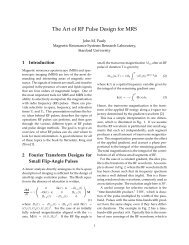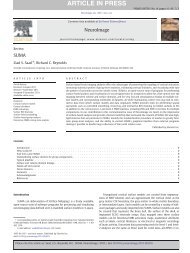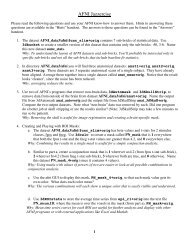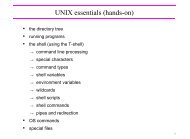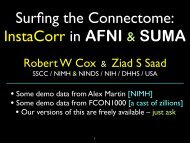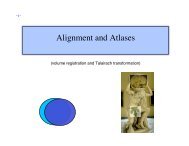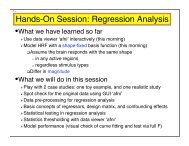Create successful ePaper yourself
Turn your PDF publications into a flip-book with our unique Google optimized e-Paper software.
–27–<strong>FMRI</strong> Experiment Design - 2• Event-related designs:! Separate activations in time so can model <strong>the</strong> <strong>FMRI</strong> response fromeach separately, as needed (e.g., in <strong>the</strong> case of subject mistakes)! Need to make inter-stimulus intervals vary (“jitter”) if <strong>the</strong>re is anypotential time overlap in <strong>the</strong>ir <strong>FMRI</strong> response curves; e.g., if <strong>the</strong>events are closer than 12-15 s in timeo O<strong>the</strong>rwise, <strong>the</strong> tail of event #x always overlaps <strong>the</strong> head of event #x+1 in<strong>the</strong> same way, and as a result <strong>the</strong> amplitude of <strong>the</strong> response in <strong>the</strong> tail of#x can’t be told from <strong>the</strong> response in <strong>the</strong> head of #x+1! Important note!o You cannot treat every single event as a distinct entity whose responseamplitude is to be calculated separately!o You must still group events into classes, and assume that all events in <strong>the</strong>same class evoke <strong>the</strong> same response." Approximate rule: 25+ events per class (with emphasis on <strong>the</strong> ‘+’)o There is just too much noise in <strong>FMRI</strong> to be able to get an accurateactivation map from a single event!–28–<strong>FMRI</strong> Experiment Design - 3• Hybrid Block/Event-related designs:! The long “blocks” are situations where you set up some continuingcondition for <strong>the</strong> subject! Within this condition, multiple distinct events are given! Example:o Event stimulus is a picture of a faceo Block condition is instruction on what <strong>the</strong> subject is to do when he sees<strong>the</strong> face:" Condition A: press button #1 for male, #2 for female" Condition B: press button #1 if face is angry, #2 if face is happyo Event stimuli in <strong>the</strong> two conditions may be identical, or at least fungibleo It is <strong>the</strong> instructional+attentional modulation between <strong>the</strong> two conditionsthat is <strong>the</strong> goal of such a study" Perhaps you have two groups of subjects (patients and controls) whichrespond differently in bench tests" You want to find some neural substrates for <strong>the</strong>se differences






